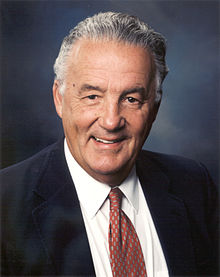
Back بول ساربانس Arabic بول ساربانس ARZ پل سربانس AZB Paul Sarbanes German Πολ Σαρμπάνης Greek Paul Sarbanes Spanish پل سربانس Persian Paul Sarbanes French פול סארביינז HE Paul Sarbanes Hungarian
Paul Sarbanes | |
|---|---|
 | |
| United States Senator from Maryland | |
| In office January 3, 1977 – January 3, 2007 | |
| Preceded by | J. Glenn Beall Jr. |
| Succeeded by | Ben Cardin |
| Chair of the Senate Banking Committee | |
| In office January 3, 2001 – January 20, 2001 | |
| Preceded by | Phil Gramm |
| Succeeded by | Phil Gramm |
| In office June 6, 2001 – January 3, 2003 | |
| Preceded by | Phil Gramm |
| Succeeded by | Richard Shelby |
| Member of the U.S. House of Representatives from Maryland | |
| In office January 3, 1971 – January 3, 1977 | |
| Preceded by | George Hyde Fallon |
| Succeeded by | Barbara Mikulski |
| Constituency | 4th district (1971–1973) 3rd district (1973–1977) |
| Member of the Maryland House of Delegates from the 2nd district | |
| In office January 18, 1967 – January 13, 1971 | |
| Personal details | |
| Born | Paul Spyros Sarbanes February 3, 1933 Salisbury, Maryland, U.S. |
| Died | December 6, 2020 (aged 87) Baltimore, Maryland, U.S. |
| Political party | Democratic |
| Spouse |
Christine Dunbar
(m. 1960; died 2009) |
| Children | 3, including John |
| Education | Princeton University (BA) Balliol College, Oxford (BA) Harvard University (LLB) |
| Signature | |
Paul Spyros Sarbanes (/ˈsɑːrˌbeɪnz/; February 3, 1933 – December 6, 2020) was an American politician and attorney from Maryland. A member of the Democratic Party, he served in both chambers of the United States Congress as a member of the United States House of Representatives from 1971 to 1977 and as a member of the United States Senate from 1977 to 2007. Sarbanes was the longest-serving senator in the History of Maryland until he was surpassed by Barbara Mikulski by a single day when her term ended on January 3, 2017.[a] He was the first Greek American senator.
Born in Salisbury, Maryland, Sarbanes was a graduate of Princeton University, Balliol College, Oxford, and Harvard Law School. Elected to the Maryland House of Delegates in 1966, he went on to serve two terms in the Maryland House from 1967 to 1971. In 1970, he won a seat in the United States House of Representatives, representing Maryland's 4th congressional district and later Maryland's 3rd congressional district from 1971 to 1977.
In 1976, he ran for the United States Senate, defeating Republican incumbent J. Glenn Beall Jr. with 59% of the vote. Sarbanes was re-elected four times, each time receiving no less than 59% of the vote. He did not seek re-election in 2006, when he was succeeded by fellow Democrat Ben Cardin. Sarbanes was known for his low-key style,[1] often shunning the limelight over his thirty-year Senate career. He was a coauthor of the Sarbanes–Oxley Act, which is generally noted as his most noteworthy piece of legislation.[2][3]
Cite error: There are <ref group=lower-alpha> tags or {{efn}} templates on this page, but the references will not show without a {{reflist|group=lower-alpha}} template or {{notelist}} template (see the help page).
- ^ Charles Babington (March 12, 2005). "Cerebral Sarbanes Aloof to Limelight". washingtonpost.com.
- ^ Greg Farrell (July 30, 2007). "The men behind the Sarbanes–Oxley Act". usatoday.com.
- ^ Dick Carozza. "An Interview with Sen. Paul S. Sarbanes Sarbanes–Oxley Act Revisited". fraud-magazine.com.